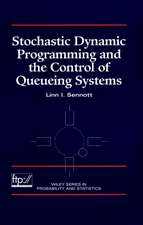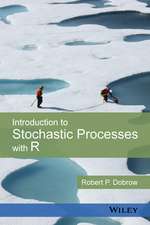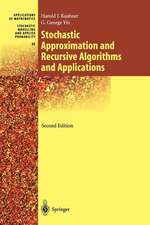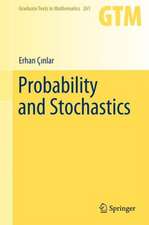Risk Theory: The Stochastic Basis of Insurance: Monographs on Statistics and Applied Probability, cartea 20
Autor R. Bearden Limba Engleză Paperback – 3 ian 2013
Preț: 391.40 lei
Nou
Puncte Express: 587
Preț estimativ în valută:
74.90€ • 81.33$ • 62.92£
74.90€ • 81.33$ • 62.92£
Carte tipărită la comandă
Livrare economică 23 aprilie-07 mai
Preluare comenzi: 021 569.72.76
Specificații
ISBN-13: 9789401176828
ISBN-10: 9401176825
Pagini: 428
Ilustrații: XVII, 408 p.
Dimensiuni: 140 x 216 x 22 mm
Greutate: 0.49 kg
Ediția:1984
Editura: SPRINGER NETHERLANDS
Colecția Springer
Seria Monographs on Statistics and Applied Probability
Locul publicării:Dordrecht, Netherlands
ISBN-10: 9401176825
Pagini: 428
Ilustrații: XVII, 408 p.
Dimensiuni: 140 x 216 x 22 mm
Greutate: 0.49 kg
Ediția:1984
Editura: SPRINGER NETHERLANDS
Colecția Springer
Seria Monographs on Statistics and Applied Probability
Locul publicării:Dordrecht, Netherlands
Public țintă
ResearchCuprins
1 Definitions and notation.- 1.1 The purpose of the theory of risk.- 1.2 Stochastic processes in general.- 1.3 Positive and negative risk sums.- 1.4 Main problems.- 1.5 On the notation.- 1.6 The moment generating function, the characteristic function, and the Laplace transform.- 2 Claim number process.- 2.1 Introduction.- 2.2 The Poisson process.- 2.3 Discussion of conditions.- 2.4 Some basic formulae.- 2.5 Numerical values of Poisson probabilities.- 2.6 The additivity of Poisson variables.- 2.7 Time-dependent variation of risk exposure.- 2.8 Formulae concerning the mixed Poisson distribution.- 2.9 The Polya process.- 2.10 Risk exposure variation inside the portfolio.- 3 Compound Poisson process.- 3.1 The distribution of claim size.- 3.2 Compound distribution of the aggregate claim.- 3.3 Basic characteristics of F.- 3.4 The moment generating function.- 3.5 Estimation of S.- 3.6 The dependence of the S function on reinsurance.- 3.7 Decomposition of the portfolio into sections.- 3.8 Recursion formula for F.- 3.9 The normal approximation.- 3.10 Edgeworth series.- 3.11 Normal power approximation.- 3.12 Gamma approximation.- 3.13 Approximations by means of functions belonging to the Pearson family.- 3.14 Inversion of the characteristic function.- 3.15 Mixed methods.- 4 Applications related to one-year time-span.- 4.1 The basic equation.- 4.2 Evaluation of the fluctuation range of the annual underwriting profits and losses.- 4.3 Some approximate formulae.- 4.4 Reserve funds.- 4.5 Rules for the greatest retention.- 4.6 The case of several Ms.- 4.7 Excess of loss reinsurance premium.- 4.8 Application to stop loss reinsurance.- 4.9 An application to insurance statistics.- 4.10 Experience rating, credibility theory.- 5 Variance as a measure of stability.- 5.1 Optimum form of reinsurance.- 5.2 Reciprocity of two companies.- 5.3 Equitability of safety loadings: a link to theory of multiplayer games.- 6 Risk processes with a time-span of several years.- 6.1 Claims.- 6.2 Premium income P(1, t).- 6.3 Yield of investments.- 6.4 Portfolio divided in sections.- 6.5 Trading result.- 6.6 Distribution of the solvency ratio u.- 6.7 Ruin probability ?T(u), truncated convolution.- 6.8 Monte Carlo method.- 6.9 Limits for the finite time ruin probability ?T.- 7 Applications related to finite time-span T.- 7.1 General features of finite time risk processes.- 7.2 The size of the portfolio.- 7.3 Evaluation of net retention M.- 7.4 Effect of cycles.- 7.5 Effect of the time-span T.- 7.6 Effect of inflation.- 7.7 Dynamic control rules.- 7.8 Solvency profile.- 7.9 Evaluation of the variation range of u(t).- 7.10 Safety loading.- 8 Risk theory analysis of life insurance.- 8.1 Cohort analysis.- 8.2 Link to classic individual risk theory.- 8.3 Extensions of the cohort approach.- 8.4 General system.- 9 Ruin probability during an infinite time period.- 9.1 Introduction.- 9.2 The infinite time ruin probability.- 9.3 Discussion of the different methods.- 10 Application of risk theory to business planning.- 10.1 General features of the models.- 10.2 An example of risk theory models.- 10.3 Stochastic dynamic programming.- 10.4 Business objectives.- 10.5 Competition models.- Appendixes.- A Derivation of the Poisson and mixed Poisson processes.- B Edgeworth expansion.- C Infinite time ruin probability.- D Computation of the limits for the finite time ruin probability according to method of Section 6.9.- E Random numbers.- F Solutions to the exercises.- Author index.



























